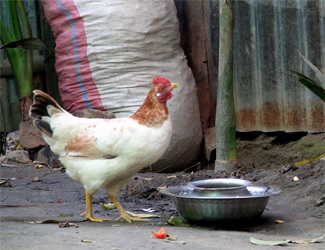Archived: Highly Pathogenic Avian Influenza A(H5N1) in Birds and Other Animals
Birds and Poultry

Highly pathogenic* avian influenza (HPAI) A(H5N1) virus occurs mainly in birds, is highly contagious among birds, and can be deadly, especially in domestic poultry.
Since December 2003, an Asian HPAI H5N1 virus has resulted in high mortality in poultry and wild birds in Asia, the Middle East, Europe, and Africa.
Asian HPAI H5N1 virus infections among domestic poultry have become common (endemic) in certain countries of the world. As of 2011, the United Nations Food and Agriculture Organization considered six countries to be endemic for Asian HPAI H5N1 virus in poultry (Bangladesh, China, Egypt, India, Indonesia, and Vietnam).
In January 2015, an HPAI H5N1 virus was detected in a wild duck in the United States. This virus is a “reassortant” virus with genes from Asian HPAI H5 viruses and low pathogenic North American viruses. (“Reassortment” occurs when the genes from two different viruses mix to create a new virus.) The HPAI H5N1 virus detected in the United States is a new combination of avian influenza genes never previously seen before. While no human cases associated with this reassortant virus have been reported, it’s possible this virus could infect people and cause serious disease. CDC has developed interim guidance on testing and prophylaxis.
See Avian Influenza in Birds for more information.
Other Animals
HPAI H5N1 viruses have been detected in other animals as well (see list below). Infection of animals other than birds with these viruses may cause illness, including severe disease and death in some infected animals.
Examples include the following:
- Asian HPAI H5N1 virus infection among pigs in China, Indonesia and Vietnam
- Asian HPAI H5N1 virus infection of cats (experimental infection of housecats in the Netherlands; isolation of HPAI H5N1 virus from domestic cats in Germany and Thailand; and detection of HPAI H5N1 viral RNA in domestic cats in Iraq and Austria)
- Asian HPAI H5N1 virus infection of dogs (isolation of HPAI H5N1 virus from a domestic dog in Thailand)
- Asian HPAI H5N1 virus infection in a wild stone marten (a weasel-like mammal) was reported in Germany and in a wild civet cat in Vietnam
- Isolation of Asian H5N1 viruses from tigers and leopards at zoos in Thailand
As HPAI H5N1 viruses continue to evolve, other mammals may become infected. For more information, see the update on avian influenza in animals from the World Organisation for Animal Health (OIE) website.
Footnotes
*Avian influenza A viruses are designated as highly pathogenic avian influenza (HPAI) or low pathogenicity avian influenza (LPAI) based on molecular characteristics of the virus and the ability of the virus to cause disease and mortality in chickens in a laboratory setting.